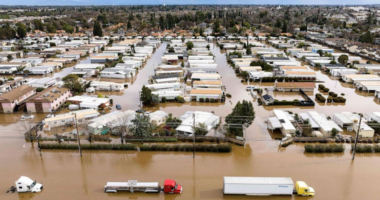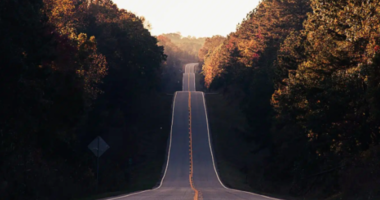Climate, Health and Equity Brief
A nation of fires and assessing your risk
May 27, 2022

The Climate, Health & Equity Brief is GMMB’s take on the week’s news on the current impacts of climate change. If you haven’t subscribed yet, you can do so by clicking here.
Hot Topic: Burning up. As grim images from space reveal, New Mexico’s Calf Canyon/Hermit’s Peak fire continues to tear through the state. The largest wildfire in the state’s history, Calf Canyon/Hermit’s Peak has eclipsed the size of the city of Los Angeles and is currently the most substantial fire in the United States. Unfortunately, it is just one of 731 wildfires currently raging across the U.S.—and summer has not yet even begun.
While you may think this is a problem for Western states alone given their arid conditions, think again: An unprecedented new Washington Post analysis shows just how much more pervasive climate-fueled fires are becoming across the entire nation.
The analysis examined factors such as worsening climate conditions, historic weather patterns, fire behavior models and ignition indicators to calculate the wildfire risk faced by every property across the U.S. and found that half of all addresses in the lower 48 states—which house one in six Americans—now face “significant” wildfire risk.
The report revealed that as climate change exacerbates drought and temperature rise nationwide, safe havens are growing increasingly rare. Wildfire risk is increasing even faster than flood risk, with states as far east as Georgia and South Carolina among those with the most homes and buildings threatened by fires.
What’s more, the communities that already bear a disproportionate burden of climate impacts and environmental injustice are now also at greatest danger from wildfires. More than 42% of the U.S. Native American population lives in areas with significant fire probability. The same is true for nearly 25% of the U.S. Hispanic population—and a majority of residents within these communities can’t afford to move, lack wildfire insurance and face job insecurity, which dramatically complicate their ability to recover after a devastating fire.
The analysis concludes with a grim warning: In the next few decades, many people will face even greater danger than they do now, and areas that are traditionally not considered wildfire-prone will soon become so without significant and urgent action to slow the effects of climate change. To determine the specific wildfire risk in your zip code, be sure to check out the tool in the Kicker below.
—Matt & Traci, GMMB
Human Health
A new Washington Post analysis utilizing First Street Foundation’s fire risk model illustrates the widespread, severe and accelerating wildfire risk across the U.S., with estimates suggesting a staggering one in six Americans now live in areas with significant fire risk. (The Washington Post)
A new study estimates that the U.S. could prevent more than 50,000 premature deaths and provide $600 billion in health benefits annually by reducing energy-related emissions from transportation, industrial activities and building functions such as heating and cooking. (The Washington Post)
A new progress report published in The Lancet Planetary Health revealed that globally, government attempts to reduce the death and disease associated with pollution have largely failed, with wildfires and fossil fuel emissions causing an estimated 6.5 million deaths per year. (Grist)
India and Pakistan are now expected to experience extreme heat events once every three years—which is 100 times more likely than the once every 312 years that was considered normal prior to the escalating impacts climate change, according to a new study. (BBC News)
Planetary Health
Experts warn that the eastward migration of wildfires is a given in the US as climate change intensifies, threatening the Midwest and the east coast with a significant increase in the coming years. (Al Jazeera)
In 2021, Earth and its oceans broke four ominous records—reaching the highest levels ever recorded of greenhouse gas concentrations, sea level rise, ocean heat and ocean acidification—according to the World Meteorological Organization’s State of the Global Climate 2021 report. (NBC News)
A new analysis found that global warming doubled the likelihood of the heavy rainfall that fueled the recent catastrophic floods and landslides in South Africa that killed 400 people and caused over $1.5 billion in infrastructure damage. (The New York Times)
From prolonged heat waves to rising sea levels to changes in crop yields, a new county-by-county analysis shows how life and the economy in the United States are set to change over the next five decades. (ProPublica)
The Calf Canyon/Hermit’s Peak wildfire in New Mexico has officially become the largest wildfire in state history, blazing through 468 square miles—an area larger than the city of Los Angeles—as containment efforts continue to be hampered by high winds and drought. (Axios)
The heating of the planet is turning landscapes into tinderboxes.”
– UN Environment Program
Equity
Experts warn that a “doom loop” of deepening debt and declining environmental conditions is imminent for the world’s poorest nations unless wealthier countries provide climate reparations, including sweeping debt cancellation to developing countries, which are responsible for the least emissions by far but bare the greatest climate impacts. (Grist)
Climate assistance funds that were meant to help rebuild areas of Texas affected by 2017’s Hurricane Harvey were diverted toward counties more than 200 miles from the affected coast, a move that the discriminated against Black and Latino residents. (The Texas Tribune)
Politics & Economy
Republican attorneys general in 17 states have asked a federal appeals court to review the EPA’s decision to allow California to set its own vehicle emission standards, citing the decision will lead to all states being forced to adopt the same strict standards. (The Los Angeles Times)
Life as We Know It
Maple syrup is the latest food item in jeopardy as North American maple trees face compounding stresses from extreme weather conditions, early sap flow, shorter sugaring seasons and intrusive insects, all of which are being driven by a warming climate. (USA Today)
Apple farmers in Indonesia are adapting to rising temperatures and prolonged rainy seasons, with some seeking cooler climates at higher altitudes while others are abandoning apples altogether to grow crops that are more climate appropriate. (Thomson Reuters Foundation)
Action
Climate-conscious consumers will soon be able to easily identify the carbon impact of the food and cosmetics they purchase, as more companies are adding carbon labeling—an indication of the carbon footprint involved in the product’s ingredients, manufacturing, shipping and end use—as part of their packaging. (Thomson Reuters Foundation)
Kicker
Are you a U.S. homeowner? Assess the potential wildfire risks to your home by entering your address into First Street Foundation’s Fire Risk Tool.
The GMMB Climate, Health & Equity Brief would not be possible without the contributions of the larger GMMB California team— Elke Cortes, Devin Della Maggoria, Sharde Olabanji and Stefana Simonetto. Feedback on the Brief is welcome and encouraged and should be sent to CHandEBrief@gmmb.com.





